This year, National Invasive Species Awareness Week (NISAW) spans from February 22-26. The goal of NISAW is to spread awareness of invasive species and the impact they have. In recognition of NISAW, the UF/IFAS Center for Aquatic and Invasive Plants is highlighting six plants invasive to Florida. To learn more, visit our interactive NISAW feature page, or read below.
Coral ardisia, Ardisia crenata
This invasive shrub is used and sold extensively in the horticulture industry as an ornamental plant. Due to its notorious bright red berries, it is often sold as a Christmas berry. Coral ardisia is a Category I invasive and has invaded and established in many natural areas across Florida. It is a prohibited plant according to the FDACS Florida Noxious Weed Index and the UF/IFAS Assessment.
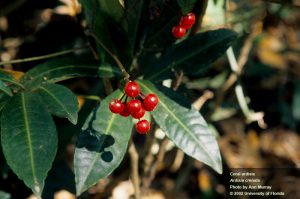
Waterhyacinth, Eichhornia crassipes
This invasive aquatic plant was introduced into the U.S. in 1884 at the Cotton States Exposition in New Orleans as an aquatic ornamental plant. Waterhyacinth forms dense, impenetrable mats which clog waterways, making boating, fishing and almost all other water activities, impossible. It also reduces biodiversity by crowding out native plants at the water’s surface and below. Water hyacinth is a Category I invasive that spreads rapidly by producing daughter plants. It is a prohibited plant according to the FDACS Florida Noxious Weed Index, the Florida Prohibited Aquatic Plants List and the UF/IFAS Assessment.
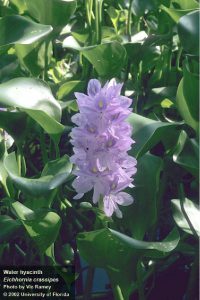
Water lettuce, Pistia stratiotes
This floating aquatic plant occurs in lakes, rivers and canals, occasionally forming large dense mats. Water lettuce commonly forms large infestations which prevent boating, fishing and other uses of lakes and rivers. This Category I invasive harbors mosquitos and is found on the Florida Prohibited Aquatic Plants List.
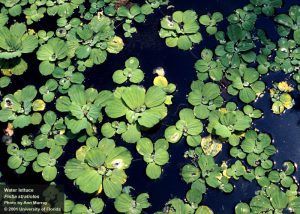
Mexican petunia, Ruellia simplex
The wild form of this Category I invasive plant has purple flowers, and was introduced to Florida in the 1940s. Mexican-petunia is able to tolerate a wide range of environmental conditions including variations in light, temperature, and moisture. Wild Mexican-petunia is a successful invasive due to its rapid growth rate, affinity for disturbed locations, prolific production of seed and lack of germination requirements such as scarification or stratification.
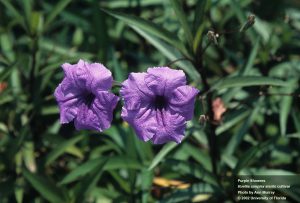
Tuberous Sword fern, Nephrolepis cordifolia
Specimens of sword fern have been found and documented in 23 counties from the Gainesville area south. Now considered a Category I invasive species, sword fern has made its presence known and continues to spread across Florida. The sword fern poses a threat to native species. Through its aggressive spread, sword fern is able to form dense stands and quickly displace native vegetation.
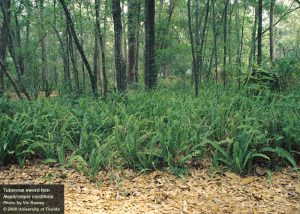
Nandina, Nandina domestica
This plant has many uses in the garden as the foliage and fruit are particularly attractive and desirable to homeowners. Unfortunately, this Category I invasive garden shrub is toxic birds and other animals, including the cedar waxwing. Its ability to grow tall quickly and reproduce by seed and root fragments becomes a major nuisance for most avid gardeners.
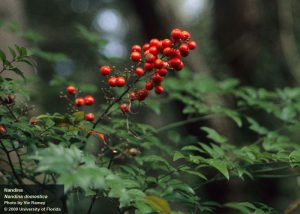
Click here for some of Florida’s invasive plants highlighted for National Invasive Species Awareness week last year.
Invasive species such as these are threatening to Florida and can have major impacts on both the economy and ecosystem. To learn more, visit https://www.nisaw.org. Any questions should be directed to Shelby Thomas at 352-273-3667 or soesterreicher@ufl.edu For more information about the UF/IFAS Center for Aquatic and Invasive Plants please visit https://plants.ifas.ufl.edu. Be sure to follow us on social @UFIFASCAIP.
UF/IFAS CAIP, Turning Science Into Solutions.
 0
0
